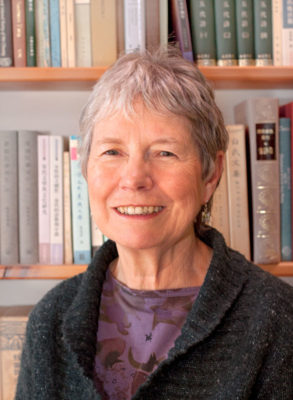 Professor Emerita, Department of East Asian Studies, University of Toronto
Professor Emerita, Department of East Asian Studies, University of Toronto
The two opportunities [the fellowships] provided to live in Japan gave me rich experiences of Japanese life that I was able to draw on for all my teaching in subsequent years.
Professor Arntzen has received 2 Japan Foundation fellowships over the course of her long and illustrious career. She attributes her successful fellowships to her three mentors/advisors in Japan.
The first one, a Graduate Dissertation fellowship, was 10 months, from September 1976 to June 1977, during which time I studied with Professor YANAGIDA Seizan (柳田聖山) at the Jinbunkagaku kenkyūjō (人文科学研究所) of Kyoto University as well as consulting with Professor HIRANO Sōjō (平野宗浄) of Hanazono University. The second senior researcher fellowship was for one year, July 1990 to June 1991; my base was Tokyo Women’s University. Professor AKIYAMA Ken (秋山虔) acted as my advisor.
Those two fellowships, together, laid the foundation for my academic career. I cannot imagine what my life would have been without them. The two opportunities they provided to live in Japan gave me rich experiences of Japanese life that I was able to draw on for all my teaching in subsequent years.
Access to research materials in Japan was, of course, helpful for the research, but more than anything else it was the generous instruction and guidance of the three scholars mentioned above that enabled me to produce worthwhile research. The regular meetings with these scholars during which I could go over difficult passages and discuss questions of general import were not just informative and stimulating, but inspiring. My gratitude to Profs. YANAGIDA, HIRANO and AKIYAMA is unending.
My gratitude is not only to my mentors but to the Japan Foundation itself for providing two amazing opportunities to pursue research in Japan. And I am only one of countless scholars who have benefited from the fellowship program.
For decades, Professor Arntzen has been a well-respected scholar in Japanese literary traditions. Her fellowships resulted in the publication of two books. She has since gone on to complete several other notable projects and has broadened her research interests in Japan.
With the graduate dissertation fellowship, I finished the research for my thesis on the life and kanbun poetry of Ikkyū Sōjun 一休宗純 (1394-1481). This intense period of research enabled me to eventually produce a volume of selected translations of the Kyōunshū 狂雲集, Ikkyū and the Crazy Cloud Anthology, University of Tokyo Press, 1986.
With the senior fellowship, I completed the basic research for my translation and study of the Kagerō nikki 蜻蛉日記 (10th C.), which was published as The Kagerō Diary: A Woman’s Autobiographical Text from the Tenth Century Japan, University of Michigan Press, 1997.
I went on to do a third translation/ study project on the Sarashina nikki, The Sarashina Diary, Columbia University Press, 2014. I am currently working on a translation of the Ochikubo monogatari. My years of teaching at the University of Alberta and then University of Toronto were certainly rewarding projects for me too. I also collaborated on several calligraphy exhibitions featuring the work of KATAOKA Shikō, one, “Woman’s Hand, Japanese Women’s Texts Through Time” that was hosted at the Japan Foundation, Toronto office in July 26 – Aug. 8, 2001.
Her time in Japan on the fellowships left Professor Arntzen with not only valuable research materials but also indelibly beautiful memories, both of people and of the country.
The quiet elegance with which he prepared the tea was a tea ceremony without ceremony and, for me, matcha always will be the taste of scholarship.
From the first fellowship, it would be the meetings with Prof. YANAGIDA in his office at Kyoto university during which he always served a cup of matcha. The quiet elegance with which he prepared the tea was a tea ceremony without ceremony and, for me, matcha always will be the taste of scholarship. The meetings with Prof. HIRANO were also memorable because they often took place at his temple, Shōzuiji 祥瑞庵 in Katada, the very place where Ikkyū had pursued his zen practice with his first master. Since Prof. HIRANO had young children, I was touched by seeing children’s toys in the formerly austere sand and stone garden. From the second fellowship period, since I had the privilege to live in the Reischauer House on the main campus, it would be having the opportunity to appreciate the beauty of Japan’s four seasons in the large garden of Tokyo Women’s University.

